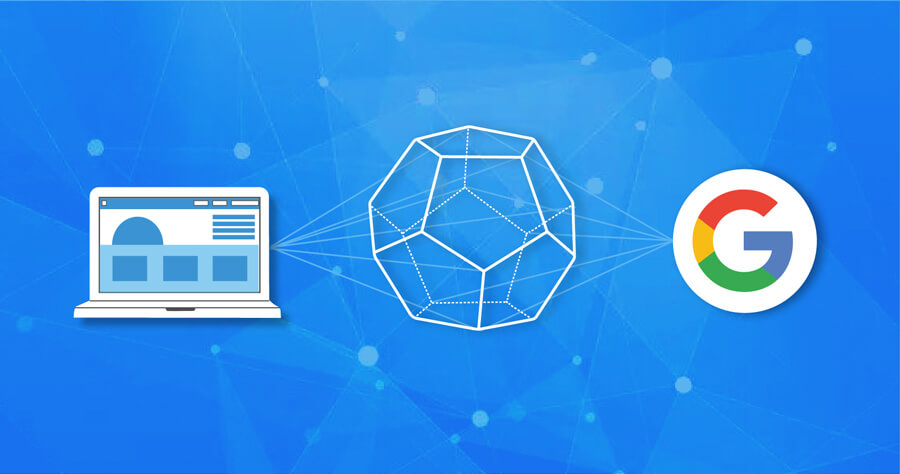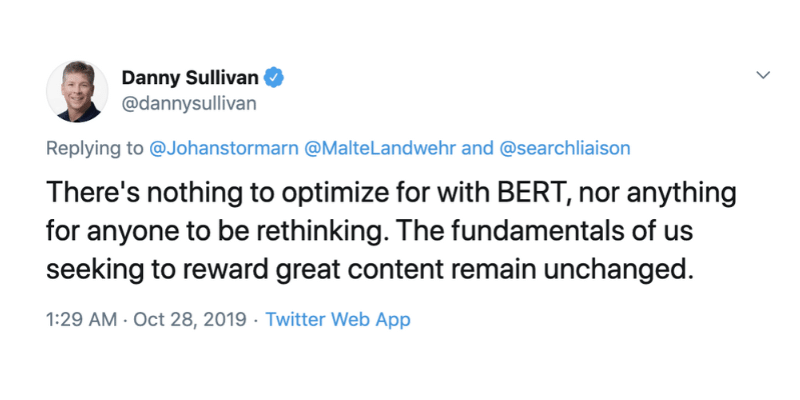The rollout of Google’s algorithm update, BERT (or Bidirectional Encoder Representations from Transformers), could be one of the most influential updates to search results in the past 5 years. The new update is estimated to affect about 10% of searches and is being used to better understand the intent behind them.
To explain Google’s reasoning behind the update, here is a snippet from Google’s October 24, 2019 press release:
“With the latest advancements from our research team in the science of language understanding–made possible by machine learning–we’re making a significant improvement to how we understand queries, representing the biggest leap forward in the past five years, and one of the biggest leaps forward in the history of Search.”
So, what exactly does this mean for SEO? According to Danny Sullivan, a well-known Google search engine liaison, it doesn’t mean a thing from an optimization standpoint:
“Write good content”. If only the SEO community had a $1 for every time they heard that! Unfortunately, great content just isn’t enough (at least in most SEO situations). The real question is: How do we turn “write good content” into actionable advice?
What is the Google BERT update?
In layman’s terms, the update is a change in Google’s processing of natural language or NLP and is meant to connect a question to an answer.
Google is looking for webpages and websites that can answer: Who, What, When, Where, Why, & How.
So if you’re looking to impress someone at a cocktail party with your copious amounts of Google BERT knowledge this holiday season, here’s what you can say: “Google’s latest update is a neural network and natural language processing technique specifically aimed to improve the currently existing word2vec model for understanding word relationships.”
Can You Optimize for Google BERT?
The short answer: you can’t optimize for BERT – but you can optimize your website’s content for users, which is basically the same thing.
A major focus for SEOs going forward should be Entity SEO, which is a type of optimization that focuses on establishing a relationship between two things.
As mentioned above, the content needs to be seen as relevant and your website needs to do all it can to establish a connection between the ranges of search intent and your site. The more you cover a niche or topic, the more “authority” or “relevance” you build for yourself (similar to how backlinks work).
What is Entity SEO?
To illustrate how Entity SEO works, we’ve googled “Who is the big guy in princess bride?” to show you how Google’s algorithm determines the results:
Honestly, this is pretty dang cool. A movie character can be surfaced in the results based on BERT / RankBrain (and a host of other algorithms working in unison), which ties into the idea of Entity SEO. To help explain how we’ve included an abstract for you to read before we dive in further with our own explanation:
“Methods, systems, and apparatus, including computer programs encoded on computer storage media, for identifying entities that are related to an entity to which a search query is directed. One of the methods includes receiving a search query, wherein the search query has been determined to relate to a first entity of a first entity type, and wherein one or more entities of a second entity type have a relationship with the first entity; receiving search results for the search query; determining that a count of search results identifying a resource containing a reference to the first entity satisfies a first threshold value (bold is author emphasis); determining that a count of search results identifying a resource having the second entity type as a relevant entity type satisfies a second threshold value; and transmitting information identifying the one or more entities of the second entity type as part of the response to the search query.”
Moving forward, it’s important for Search Engine Optimizers to improve their understanding of Entity as it pertains to Google. Why? We’ve noticed trends in Google’s most recent core algorithm updates (RankBrain, Medic, and BERT) are favoring this concept.
Here is an image to help you visualize:
Clear as mud? Good.
The key to understanding the relationship between Entity and SEO is in Section 404 of Figure 4 on the Google patent shown above where it states: “a sufficient number of resources identified by the search results are authoritative resources for a particular entity.”
Keyword difficulty taps into this idea slightly, although it doesn’t quite hit the nail on the head. Because although it a helpful metric, it fails to account for the strength of entity association.
Additionally, backlinks aren’t the only thing that creates “a sufficient number of resources” as mentioned above. Which means that domain authority or the domain rating metric isn’t quite able to calculate what Google is trying to do either.
To summarize, the goal for Google is to form a relationship between queries in various contexts with websites and webpages to form a ‘confidence score’ (similar to how Google’s Vision API works) that enables them to connect a search query back to your page. The better you are at creating Entity association the more likely you are to be trusted by Google as an authority.
Using Google’s own SERP to Understand Entity Relationships
This is a fun exercise that was referenced in a previous post on keyword mapping and keyword research.
If you want to understand the current entity understanding that Google has, then just enter your keyword and identify the “people also ask”, “autosuggest”, “image result” boxes, and the “people also search for” sections (located at the bottom of the SERP):
“Storage company” is related to moving, public, pod, business, self-storage, yellow, portable, and locker. It’s interesting to see that a brand “yellow” is connected this strongly with an entity-relationship. When I use Raven’s keyword rank checker to see the strength of the keyword profile, we see why “yellow” pops up in the search results for this query:
“Nearest storage to me” as a phrase gets 300k searches. Guess who is at position 28? Yellow. “London Storage” at position 1? Yellow. We would wager that if “Yellow” wanted to lean into their SEO campaign, they could acquire much more organic real estate, especially since BERT and associated algorithms all rely so heavily on the science of determining entity.
How to Win Post-BERT
To dominate the SERPs in 2019 and 2020, begin to get creative when tying one entity to another (i.e. company = keyword). You don’t just do this by building authority through links. Link diversity, brand prominence (popularity), content relevance, general niche authority (arguably another way of describing relevance), and of course, the technical aspect of your site, will all play a part in ranking.
Don’t just rely on a technical SEO 100/100 score. You’ll need a lot of web pages, a lot of internal links, a lot of content covering a semantic range, and you’ll need to create a heavy web footprint that connects your brand to the keywords you’re hunting for.
Good luck!
-The Raven Team
Further Reading – Bibliography
https://arxiv.org/pdf/1810.04805.pdf
https://www.briggsby.com/on-page-seo-for-nlp









